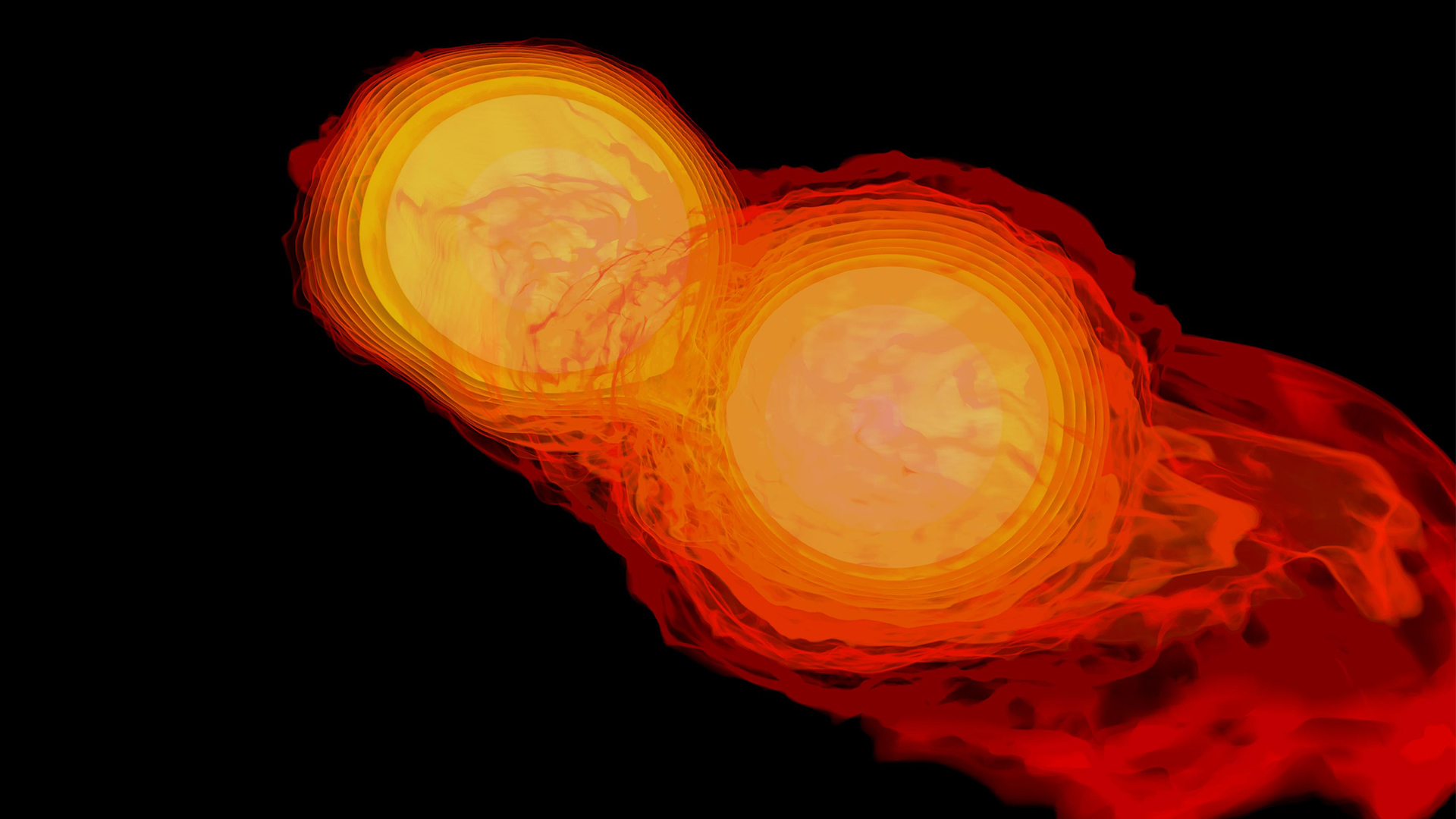'Remarkable' explosions from colliding, dead stars could reveal the true expansion rate of the universe
Two conflicting methods to measure the expansion rate of the universe give different results, but researchers could resolve the disparity by watching merging neutron stars explode.

The collision and merger of two stellar corpses called neutron stars could help scientists unravel a long-standing mystery surrounding the expansion rate of the universe.
Since the early 1900s, scientists have known that the universe is expanding. The discovery was made thanks to astronomer Edwin Hubble's observation that the more distant galaxies are from each other, the more quickly the gap between them grows.
The rate of the universe's expansion is known as the Hubble constant, and it has become a major headache for astronomers. This is because two methods of determining this rate — observations of distant stellar explosions called supernovas, which can be used as "standard candles" to gauge cosmic distances, and the cosmic microwave background (CMB), the light left over from just after the Big Bang — yield different values for cosmic expansion.
Related: Extremely flat explosion dubbed 'the Cow' defies explanation
This "Hubble trouble" has deepened as these independent measurement methods of the Hubble constant have become more precise, meaning the disparity between them has not only persisted but can no longer be explained by measurement uncertainties. That has inspired scientists to hunt for a third way to determine the Hubble constant — one that is independent of measuring supernovas or the CMB.
Now, in a paper published in the journal Astronomy & Astrophysics, astrophysicists suggest that colliding neutron stars could be the third method needed to resolve the Hubble trouble.
"When two ultra-compact neutron stars — which in themselves are the remnants of supernovae — orbit each other and ultimately merge, they go off in a new explosion, a so-called kilonova," lead study author Albert Sneppen, a doctoral candidate in astrophysics at the Niels Bohr Institute's Cosmic Dawn Center in Denmark, said in a statement. The team recently demonstrated how this explosion is remarkably symmetrical, he said, and "it turns out that this symmetry is not only beautiful but also incredibly useful."
The symmetry of a kilonova — the electromagnetic component of a neutron star merger — contradicts prior models that suggested these collision-driven explosions should have a flattened shape. In addition, Sneppen also recently found that, despite their complexity, kilonovas can be described by a single temperature and are, therefore, perfect radiators — something physicists call a "blackbody."
Get the world’s most fascinating discoveries delivered straight to your inbox.
The spherical nature of a kilonova and its simple temperature profile allow astronomers to calculate their luminosity very precisely. By comparing the kilonova's brightness at the point of explosion to the amount of light from the explosion that travels millions of light-years to finally wash over Earth, scientists can determine the distance of the neutron star collision. This is because the light loses energy in a set way as it travels thanks to the expansion of the universe. That results in a way to measure the distance to galaxies hosting kilonovas, and thus another way to determine cosmic distances — one that has an advantage over supernova measuring schemes.
"Supernovae, which until now have been used to measure the distances of galaxies, don't always emit the same amount of light," study co-author Darach Watson, an associate professor at the Cosmic Dawn Center, said in the statement. "Moreover, they first require us to calibrate the distance using another type of star, the so-called Cepheids, which in turn also must be calibrated. With kilonovae, we can circumvent these complications that introduce uncertainties in the measurements."
The team has already put its kilonova Hubble constant measurement method to the test. To do so, they focused on a kilonova that's located around 140 million light-years from Earth and was discovered in 2017. This outburst of light, around 1,000 times less powerful than a typical supernova, gave a value for the Hubble constant that is closer to the value delivered by CMB-based measurement techniques than to supernova-based alternatives.
However, this one test alone won't put the Hubble trouble to bed, the team cautioned.
"We only have this one case study so far and need many more examples before we can establish a robust result," Sneppen said. "But our method at least bypasses some known sources of uncertainty and is a very 'clean' system to study. It requires no calibration, no correction factor."
Robert Lea is a science journalist in the U.K. who specializes in science, space, physics, astronomy, astrophysics, cosmology, quantum mechanics and technology. Rob's articles have been published in Physics World, New Scientist, Astronomy Magazine, All About Space and ZME Science. He also writes about science communication for Elsevier and the European Journal of Physics. Rob holds a bachelor of science degree in physics and astronomy from the U.K.’s Open University




